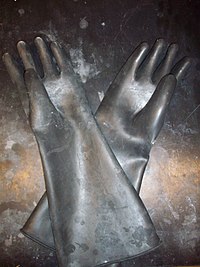Butyl rubber
This lead section may be too technical for most readers to understand. (January 2019) |

Butyl rubber, sometimes just called "butyl", is a
Properties
Butyl rubber has excellent impermeability to gas diffusion, and the long polyisobutylene segments of its polymer chains give it good flex properties.
The formula for PIB is: –(–CH2–C(CH3)2–)n–
It can be made from the
A synthetic rubber, or
History
Isobutylene was discovered by Michael Faraday in 1825. Polyisobutylene (PIB) was first developed by the BASF unit of IG Farben in 1931 using a boron trifluoride catalyst at low temperatures and sold under the trade name Oppanol B. PIB remains a core business for BASF to this day.
It was later developed into butyl rubber in 1937, by researchers
PIB homopolymers of high molecular weight (100,000–400,000 or more) are polyolefin elastomers: tough extensible rubber-like materials over a wide temperature range; with low density (0.913–0.920), low permeability and excellent electrical properties.
In the 1950s and 1960s,
In the spring of 2013 two incidents of PIB contamination in the English Channel, believed to be connected, were described as the worst UK marine pollution 'for decades'. The RSPB estimated over 2,600 seabirds were killed by the chemical and hundreds more were rescued and decontaminated.[2]
Uses
Fuel and lubricant additive
Polyisobutylene can be reacted with
As a
Polyisobutylene is used in some formulations as a thickening agent.
Explosives
Polyisobutylene is often used by the
Polyisobutylene binder is used because it makes the explosive more insensitive to premature detonation as well as making it easier to handle and mold.Speakers and audio equipment
Butyl rubber is generally used in speakers, specifically the surrounds. It was used as a replacement for foam surrounds because the foam would deteriorate. The majority of modern speakers use butyl rubber, while most vintage speakers use foam.
Sporting equipment
Butyl rubber is used for the bladders in sporting balls (e.g. Rugby balls, footballs, basketballs, netballs) and to make bicycle inner tubes to provide a tough, airtight inner compartment.
Damp proofing and roof repair
Butyl rubber sealant is used for damp proofing, rubber roof repair and for maintenance of roof membranes (especially around the edges). It is important[citation needed] to have the roof membrane fixed, as a lot of fixtures (e.g., air conditioner vents, plumbing, and other pipes) can considerably loosen it.
Rubber roofing typically refers to a specific type of roofing materials that are made of ethylene propylene diene monomers (EPDM rubber). It is crucial to the integrity of such roofs to avoid using harsh abrasive materials and petroleum-based solvents for their maintenance.
Polyester fabric laminated to butyl rubber binder provides a single-sided waterproof tape that can be used on metal, PVC, and cement joints. It is used for repairing and waterproofing metal roofs.
Gas masks and chemical agent protection
Butyl rubber is one of the most robust elastomers when subjected to
Pharmaceutical stoppers
Butyl and bromobutyl rubber are commonly used for manufacturing rubber stoppers used for sealing medicine
Chewing gum

Most modern chewing gum uses food-grade butyl rubber as the central gum base, which contributes not only the gum's elasticity but also gives it a stubborn, sticky quality which has led some municipalities to propose taxation to cover costs of its removal.[10]
Recycled chewing gum has also been used as a source of recovered polyisobutylene. Amongst other products, this base rubber has been manufactured into coffee cups and 'Gumdrop' gum-collecting bins.[11][12] When filled, the collecting bins and their contents are shredded together and recycled again.
Tires
Because of their superior resistance to gas diffusion, butyl rubber and halogenated rubber are used for the innerliner inside pneumatic tubeless tires, and for the inner tube in older tires.
Insulating windows
Polyisobutylene is used as the primary seal in an insulating glass unit for commercial and residential construction providing the air and moisture seal for the unit.
Notes
- ^ "Butyl Rubber: A Techno-commercial Profile". Chemical Weekly. 55 (12): 207–211. November 3, 2009.
- ^ "biggest UK pollution incident for decades". London Guardian. 3 May 2013.
- ^ "Polyisobutylene Succinimides in Engine Oil". Lubrizol. Archived from the original on 2017-02-15. Retrieved 2017-02-14.
- .
- ^ "Case Studies: Minimizing Worker Exposure to Mist in the Auto Industry". Green Engineering. Environment Protection Agency. 29 April 2015.
- PMID 7529704. Archived from the originalon 2005-11-25.
- ^ "04-87 BASF Corp. v. United States" (PDF). Slip Opinions. United States Court of International Trade. 2004-07-15. Archived from the original (PDF) on 2006-09-23.
- ^ "Explosives - Compounds". Global Security.
- ^ "Halobutyl rubber for pharmaceutical stoppers and seals". ExxonMobil Chemical.
- ^ "Making "Greener" Chewing Gum". American Chemical Society. Archived from the original on 2015-12-24. Retrieved 2015-12-23.
- ^ "Gumdrop Ltd". Retrieved 2018-03-13.
- ^ Shaw, Dougal (2018-03-06). "The chewing gum you don't mind stuck to your shoe". BBC News Online. Retrieved 2018-03-13.
External links
- Brief overview of Polyisobutylene
- Additional information
- Physical properties and other information for various polyisobutylene (PIB) grades

